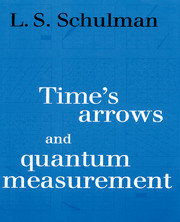Book contents
- Frontmatter
- Contents
- Preface
- 1 Introduction
- 2 Irreversibility
- 3 Arrows of time
- 4 Correlating arrows of time
- 5 Two-time boundary value problems
- 6 Quantum measurements: cats, clouds and everything else
- 7 Existence of special states
- 8 Selection of special states
- 9 Abundance of special states
- 10 Experimental tests
- 11 Conclusions and outlook
- Author index
- Index
11 - Conclusions and outlook
Published online by Cambridge University Press: 05 August 2012
- Frontmatter
- Contents
- Preface
- 1 Introduction
- 2 Irreversibility
- 3 Arrows of time
- 4 Correlating arrows of time
- 5 Two-time boundary value problems
- 6 Quantum measurements: cats, clouds and everything else
- 7 Existence of special states
- 8 Selection of special states
- 9 Abundance of special states
- 10 Experimental tests
- 11 Conclusions and outlook
- Author index
- Index
Summary
Less than meets the eye
If even some of the ideas presented here are correct, the world is different from what it seems. The major theses of the book, on time's arrows and on quantum measurement theory, are unified by the notion of cryptic constraints. We see, sense, specify, macroscopic states, but what we predict about these states depends on an important assumption concerning their microscopic situation. The assumption is that the actual microstate is equally likely to be any of those consistent with the macrostate. And I say, not so. For various reasons, both classical and quantum, many otherwise-possible microstates are eliminated. As presented in detail in previous chapters, such elimination impacts many areas of physics, from the cosmos to the atom. But we also make the point that this elimination can be difficult to notice and in particular there is no experimental evidence that confirms the usual assumption. By an explicit example on a model (Fig. 4.3.2), we show that a future constraint eliminating 98% of the microstates can go completely unnoticed.
My expectation is that this fundamental change in the foundations of statistical mechanics is needed. Whether or not it takes the forms I've proposed will be determined by future investigations.
In the next section I will review open problems for the program implicit in this book. The tone will be that used in speaking with colleagues: an attempt to be frank about difficulties and a willingness to be wildly speculative.
- Type
- Chapter
- Information
- Time's Arrows and Quantum Measurement , pp. 326 - 332Publisher: Cambridge University PressPrint publication year: 1997



